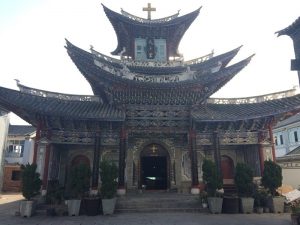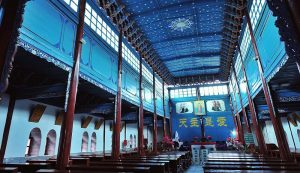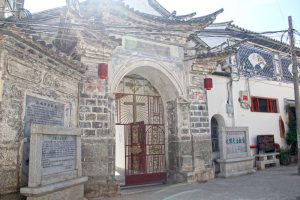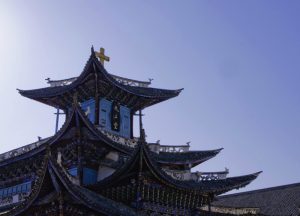Catholic Church of Dali Old Town in Dali City

Chinese Name: 大理古城天主教堂
Chinese Pinyin: Da Li Gu Cheng Tian Zhu Jiao Tang
English Name: Catholic Church of Dali Ancient Town
Type: historical relics, church
Altitude: about 3500m~4159m
Recommended Visiting Hours: about 1 hours
Opening Hours: all the day
Ticket: no entrance ticket fee
Location: Cangping Street, Fuxing Road, Dali City, Yunnan Province, China; 13 km from Xiaguan Town of Dali
Catholic Church of Dali Ancient Town

The Catholic Church of Dali Ancient Town is located in a quiet alley of Renmin Road, Dali Ancient Town. It was built in 1927. The official introduction of Catholicism to Yunnan was in the late Ming and early Qing dynasties. The architectural features of the church are unique, regarded as the national treasure that blends the characteristics of the local Bai culture with the Han and Western architecture, enjoying a flying arch and a beautiful painting. The Dali is Ancient Town is beautiful, quiet and charming. It has rich multi-ethnic culture and traditional Chinese Han culture, and the unique combination of Western culture. Catholic Church is the evidence of the integration of Chinese and Western culture.
Why is Catholic Church of Dali Ancient so special?
The Catholic Church shows the harmony of Chinese and Western culture. The church is the combination of the features of Bai, Han and Western architecture. In 1983, it was entitled as the “Relics Protection Unit” by the Dali Cultural Relics Department.
Where is Catholic Church?
The Catholic Church is in Dali Ancient Town, located at the north of Xiaguan Town, 13 kilometers away. This ancient city is situated between Cangshan Mountain and Erhai Lake.
Distance from other famous attractions in Dali
About 5 kilometers from Erhai Lake
About 2.3 kilometers from Three Pagodas of Dali
About 1.9 kilometers from Cangshan Mountain
About 24.7 kilometers from Shuanglang
How to Get to Catholic Church?
Travelers can use our private car taking to Dali Ancient Town from Dali Airport or Dali Railway Station at first. If you are independent travelers, you can take bus or go by taxi.
1.By Car
From Dali Airport: It is about 30 km from Dali Airport to Dali Ancient Town. There are airport shuttle running between the airport to Dali Old Town. The drive takes about 40 minutes. If by taxi, it may cost around 80~100 Yuan.
From Dali Railway Station: It is about 26 km from Dali Railway Station to Dali Ancient Town. Travelers can take No.8 bus outside of the railway station to Dali Ancient Town, which takes about 40 minutes. If by taxi, it may cost around 50 Yuan.
2.By Bus

Taking bus No.4, No.8 in Xiaguan about 40 minutes to the Dali Ancient Town, the fare is 2 yuan. People who take bus No.8 can choose to get off at the east gate. In Yuer road there is touring bus passing Wind Flower Snow and Moon Hotel, Guozi Garden, Bluestone Bridge, Yeyu Road, Yuer Park, Boai Crossing and Cangshan Mountain Gate. In addition, visitors can take the minibus to Dali Ancient Town in Jianshe Road and Cultural Road, about 30 minutes to reach the old city. There are three options of transportation of electronic mobile, mountain bike and walk for tourists in Dali Ancient Town.
History of Cotholic Church
The official introduction of Catholicism into Yunnan was in the late Ming and early Qing dynasties. There were two main ways: First, the Queen, and the royal family members of the “Yongli Royal Family” in Nanming; second, some Tibetan members migrated to Sichuan. In the northeastern part of Yunnan, which is today’s northeastern part of Zhaotong, Yanjin County, and then Sichuan priests went from Yibin to Yunnan for pastoral visits and missionary work, which led to the further development of Catholicism in Yunnan.
In 1696, with the increasing number of church members, Yunnan established a pastoral area, but for various reasons, the two bishops did not take up their posts, so they were later merged into the Sichuan Diocese.
In 1840, the Yunnan Diocese was established again. The Bishop’s Office was set up in Longxi Village, Yanjin County, Zhaotong. Later, in 1876, it moved to Kunshan East Road to establish the Bishop’s Office. In 1936, it moved to its current address. With the continuous development of Catholicism in Yunnan, by 1946, Yunnan was divided into three parishes of Kunming, Dali and Zhaotong. The Dali diocese was established in 1929.
Architecture Feature

When we step into a narrow and quaint little street full of Bai architecture, we will see a quaint church that blends traditional Chinese and Bai architectural styles. Its church architecture is unique. It is famous for its unique style of architectural structure, exquisite carving art, and the blending of Chinese and Western architecture. At home and abroad, priests and tourists from all over the world come here to visit and visit.
According to the local old believers, the church was built in 1927. In 1983, with the support of the relevant government departments, the church was completely renovated. It was completed and opened at the end of the year. The church is a Bai temple style. The altar in the church is made of locally marble. The church is carved and painted inside and outside, and has a strong Bai architectural style. The “four-in-five patio” of the church’s annex building complements the main building of the church, echoing each other, and the flowers and trees are hidden among them, making the whole church more religious, quiet and full of vitality.
From the front, the church looks like a flying dragon, reflecting the strong traditional Chinese cultural thoughts – the descendants of dragon, Chinese; from the side, it looks like a huge ship, symbolizing the church as anchored by Noah’s Ark. Voyage brings hope, justice, peace and love to mankind. According to local people, the shape of the church is also taken from the Bible, Luke 8:22-25. Jesus calms the teachings and connotations of the storm. As long as there is love and peace, people can overcome difficulties.

Walking into the church, it seems to have entered ancient galleries and museums. The northern walls are covered with ancient and excellent Western paintings. The south wall is inlaid with a beautiful Chinese landscape painting. The front three paintings and the middle one are churches. According to the introduction, there are more than 60 paintings on the entire church wall, which give us the wonderful enjoyment, endless reverie and thinking. Localization and situationalization are the best ways to spread and survive and develop. It is also the cause we are striving for and engaged in now.
Nearby Attractions
Dali Ancient Town is a historic town with rich culture located between Cangshan Mountain and Erhai Lake. Unlike any other Chinese town, the traditional Bai ethnic houses give the town distinctive feel. Travelers can wonder in this leisure town to appreciate the unique ethnic architecture and discover its profound history and culture.
The Three Pagodas,the symbolic building of Dali, was first built in the time of Nanzhao Kingdom and Dali Kingdom in 9th and 10th century. Looking from a distance, the pagodas are like three ballpoint pens standing between the magnificent Cangshan Mountain and elegant Erhai Lake.
Best Time to Visit
Dali Ancient Town is a very comfortable and leisure site which can be visited all year round. There is a saying going “Good Scenery is the month of March”. March to April is the best time to visit Dali Ancient City. If you want to enjoy Bai’s grand festival, you can come in the beautiful spring and catch the rare chance to join in March Fair.
Useful Travel Tips
1.Best Time to Visit
A lot of festivals and events of Bai nationality focused on March to April each year, travel at this time you will feel rich ethnic customs. And there is a song: “March in Dali has good scenery”, so in the spring, it is suitable whether it is traveling to Dali, or climbing Canshang Mountain, visiting Erhai Lake.
2. What to Pack
Dali belongs to the low altitude plateau monsoon climate and ultraviolet ray is strong. Travelers should bring usual clothes and necessities as well as sunscreen cream and sunglasses to protect yourselves.

 7 Days GolfingTour
7 Days GolfingTour
 8 Days Group Tour
8 Days Group Tour
 8 Days Yunnan Tour
8 Days Yunnan Tour
 7 Days Shangri La Hiking
7 Days Shangri La Hiking
 11 Days Yunnan Tour
11 Days Yunnan Tour
 6 Days Yuanyang Terraces
6 Days Yuanyang Terraces
 11 Days Yunnan Tour
11 Days Yunnan Tour
 8 Days South Yunnan
8 Days South Yunnan
 7 Days Tea Tour
7 Days Tea Tour
 8 Days Muslim Tour
8 Days Muslim Tour
 12 Days Self-Driving
12 Days Self-Driving
 4 Days Haba Climbing
4 Days Haba Climbing
 Tiger Leaping Gorge
Tiger Leaping Gorge
 Stone Forest
Stone Forest
 Yunnan-Tibet
Yunnan-Tibet
 Hani Rice Terraces
Hani Rice Terraces
 Kunming
Kunming
 Lijiang
Lijiang
 Shangri-la
Shangri-la
 Dali
Dali
 XishuangBanna
XishuangBanna
 Honghe
Honghe
 Kunming
Kunming
 Lijiang
Lijiang
 Shangri-la
Shangri-la
 Yuanyang Rice Terraces
Yuanyang Rice Terraces
 Nujiang
Nujiang
 XishuangBanna
XishuangBanna
 Spring City Golf
Spring City Golf
 Snow Mountain Golf
Snow Mountain Golf
 Stone Mountain Golf
Stone Mountain Golf














